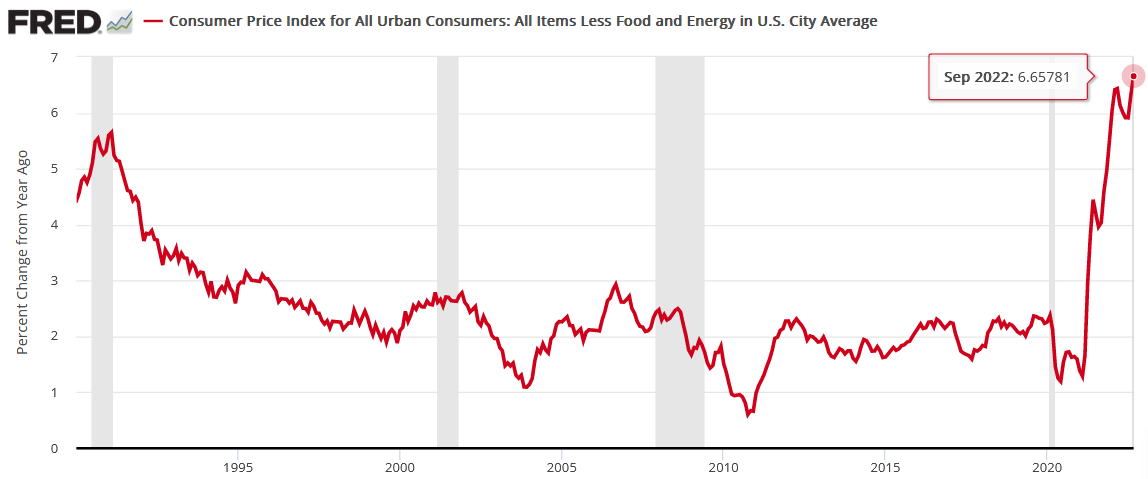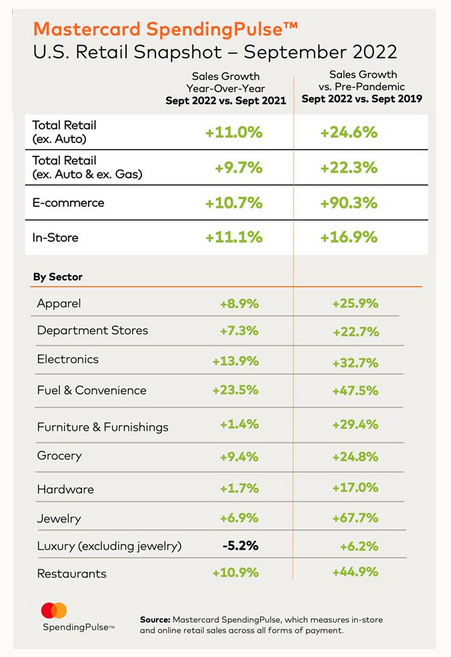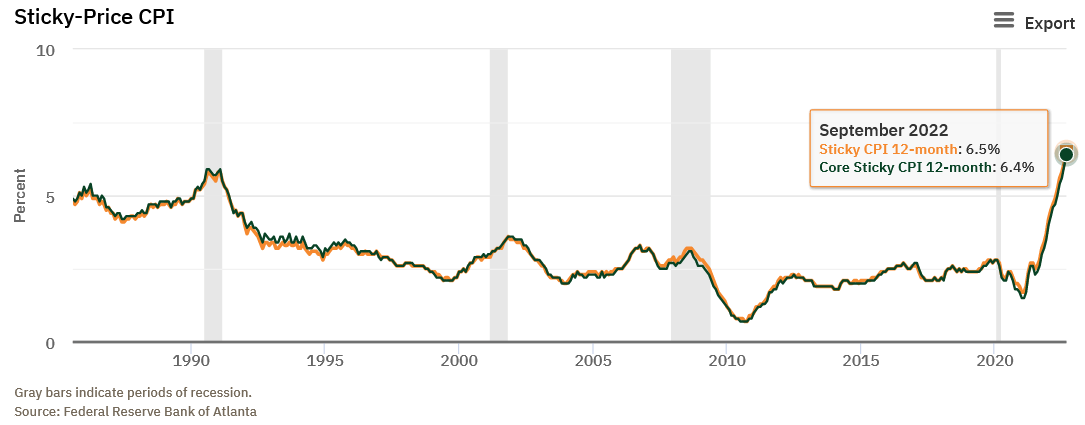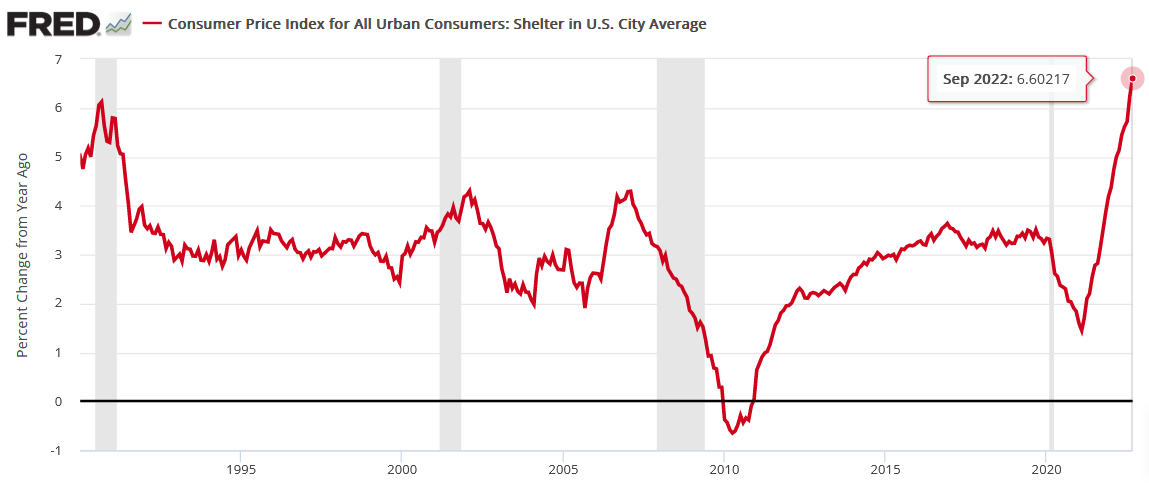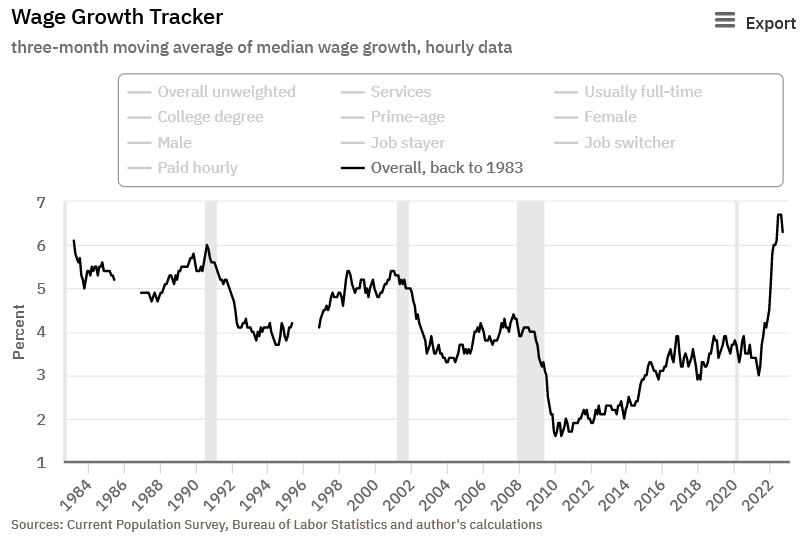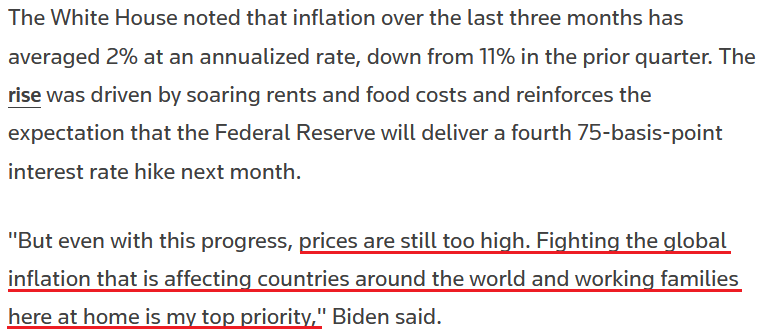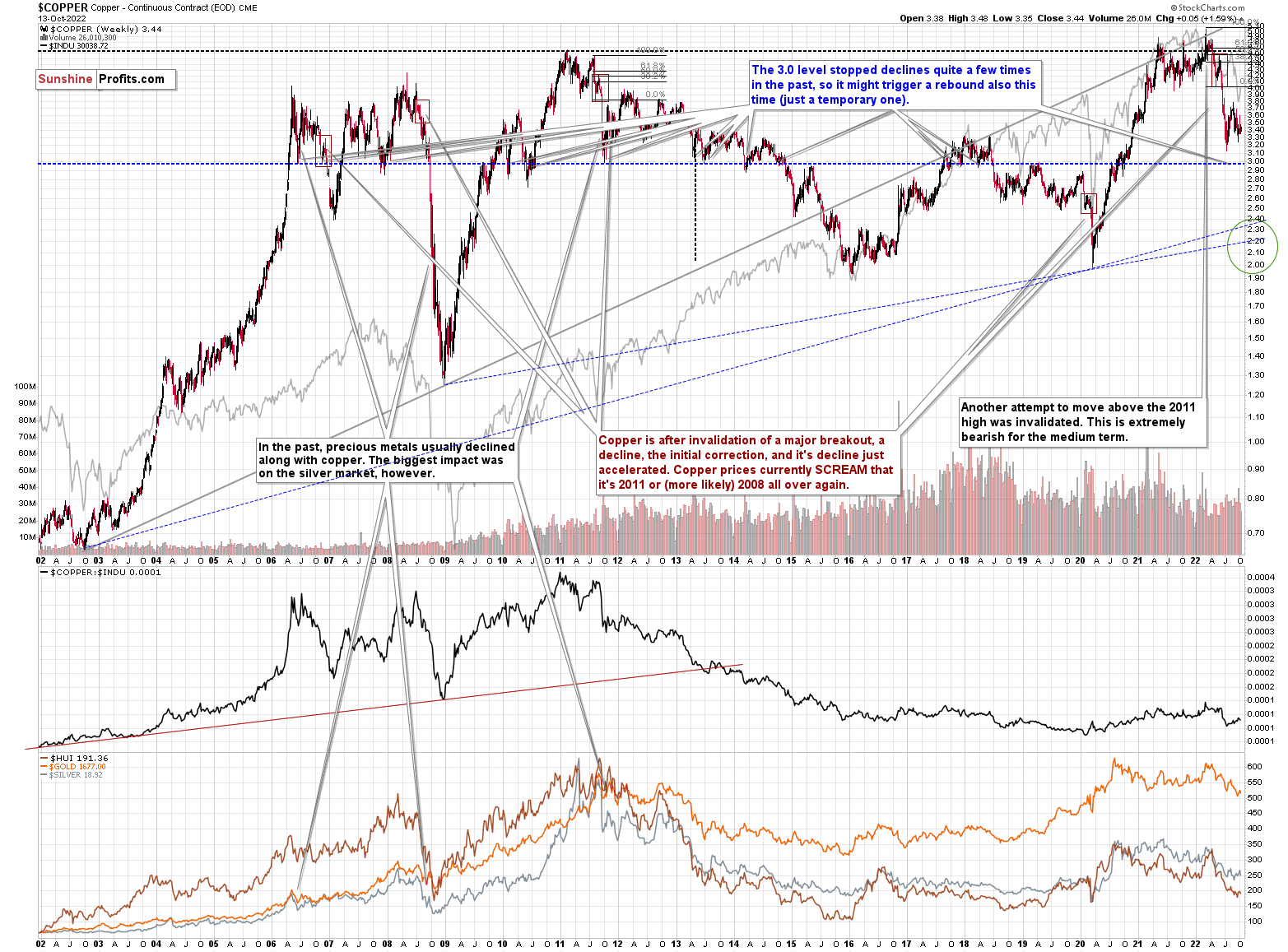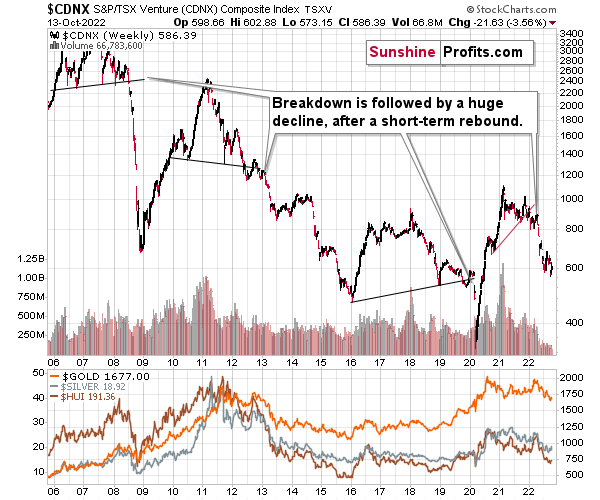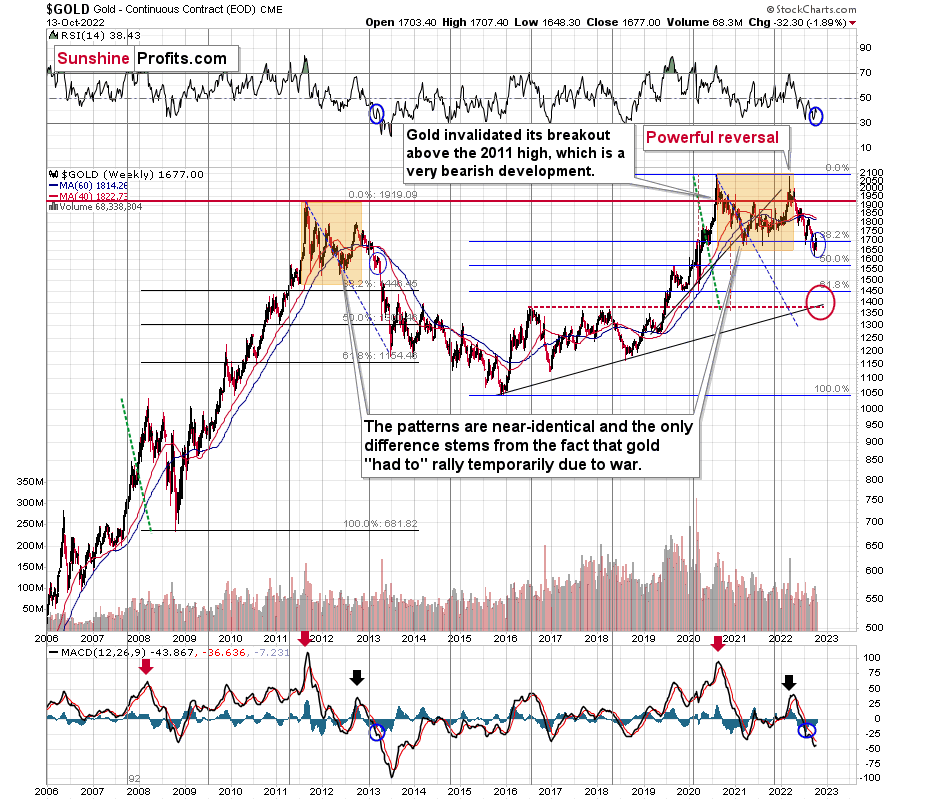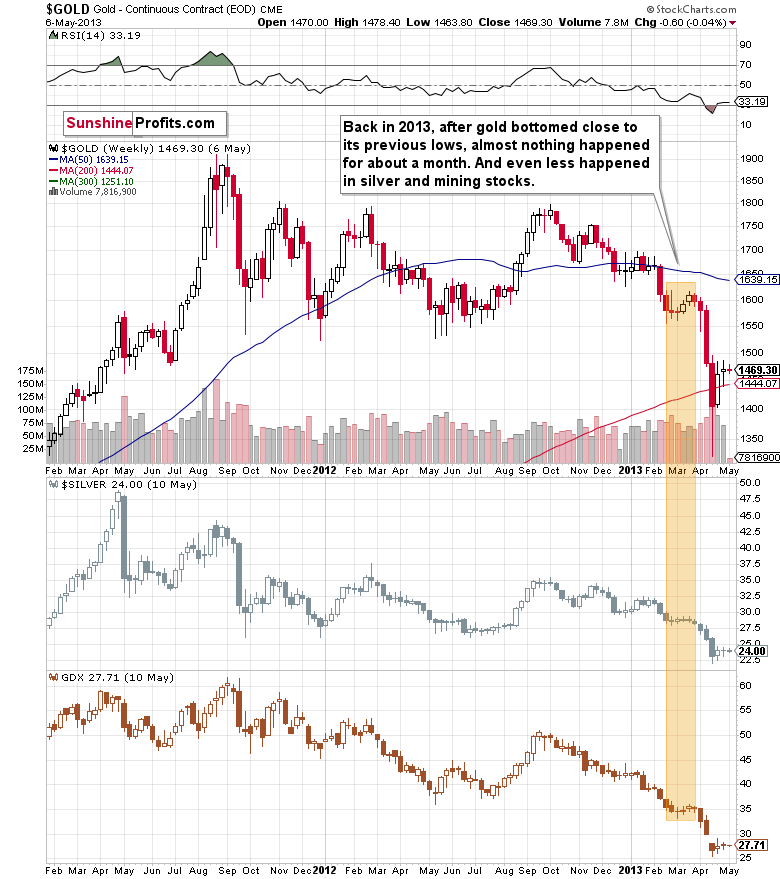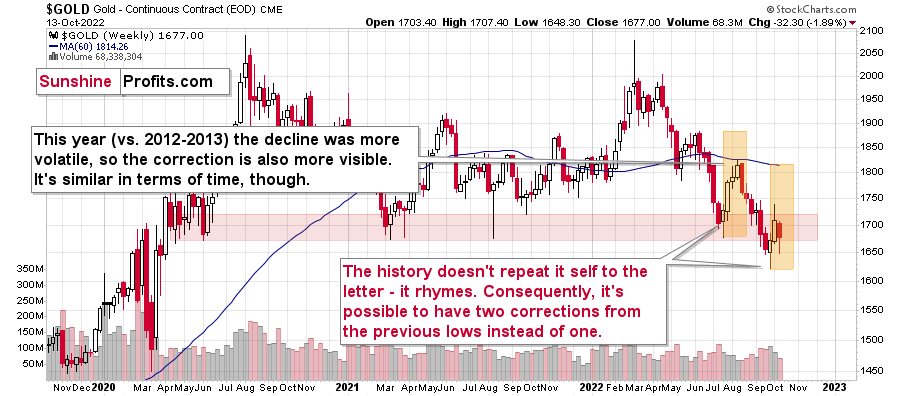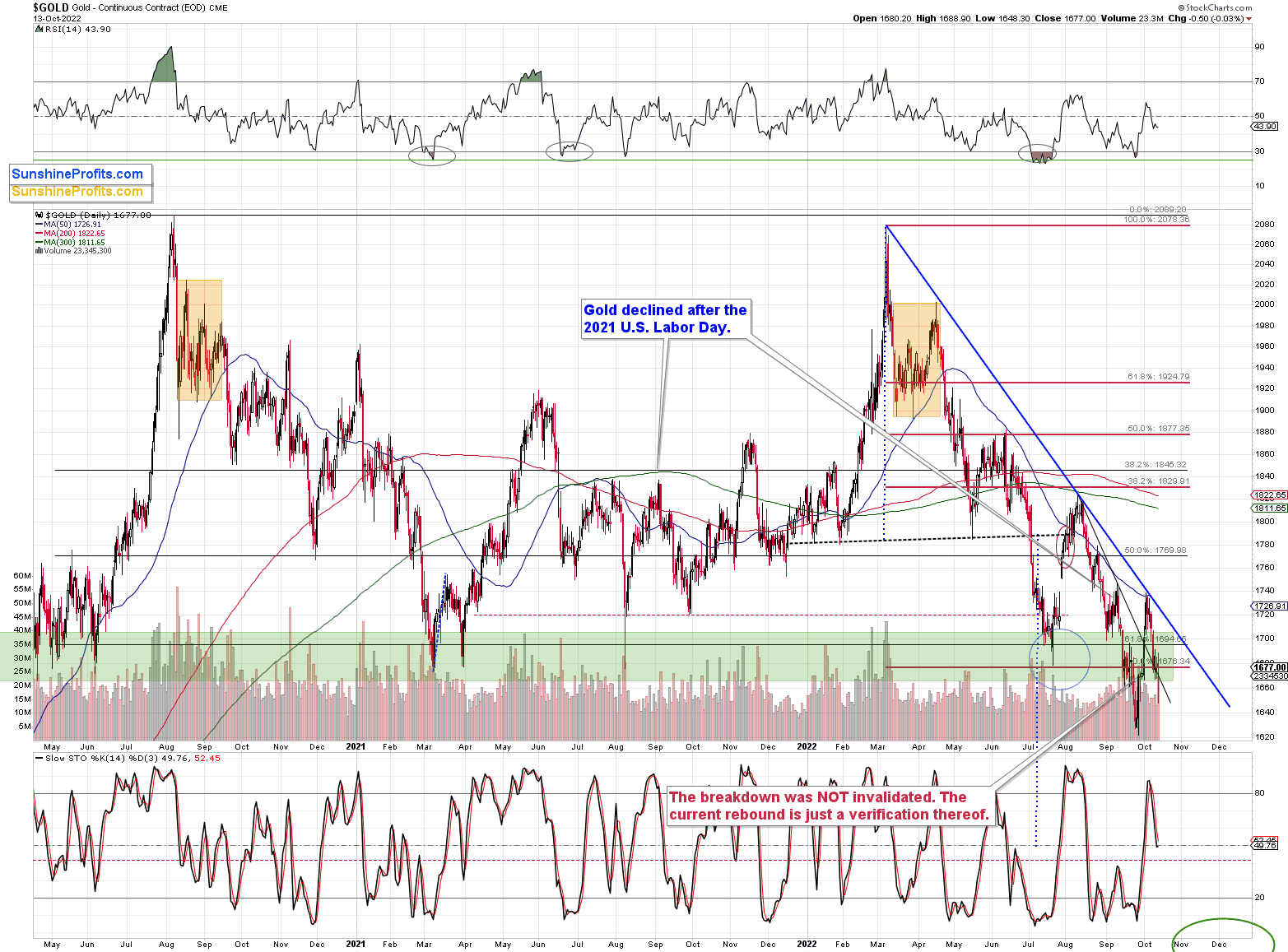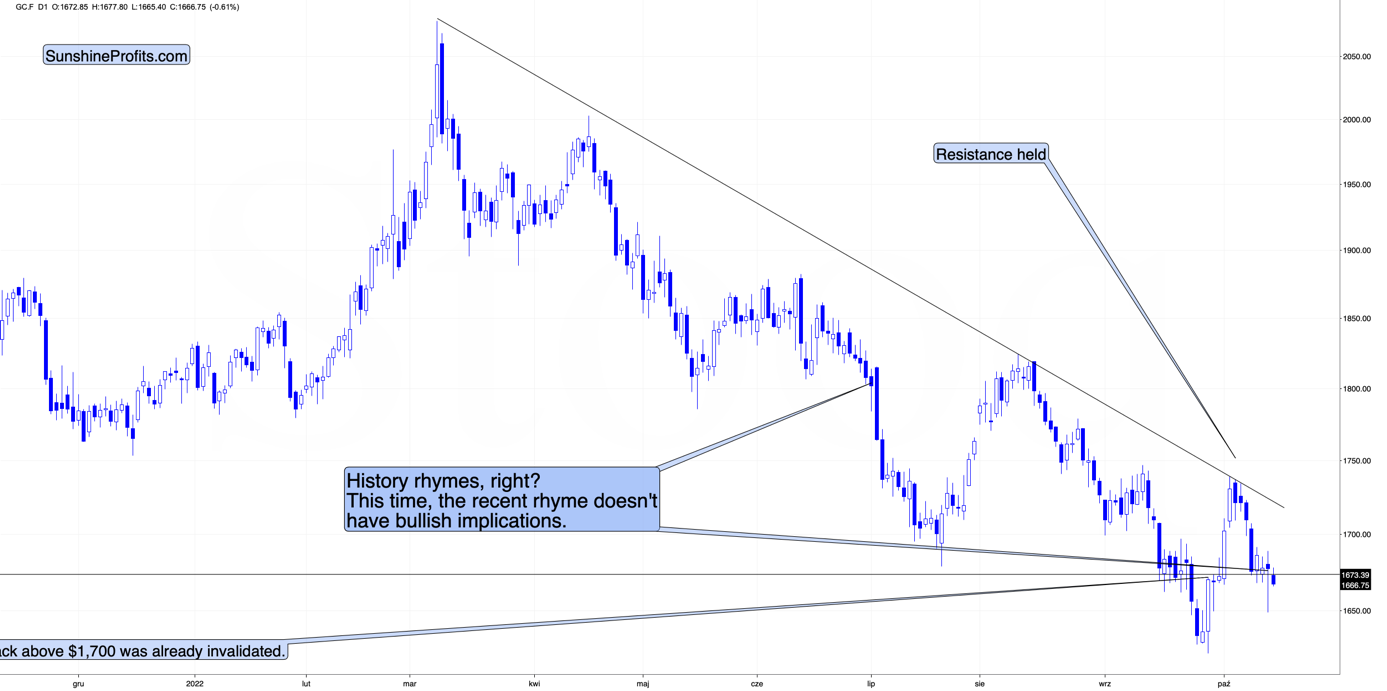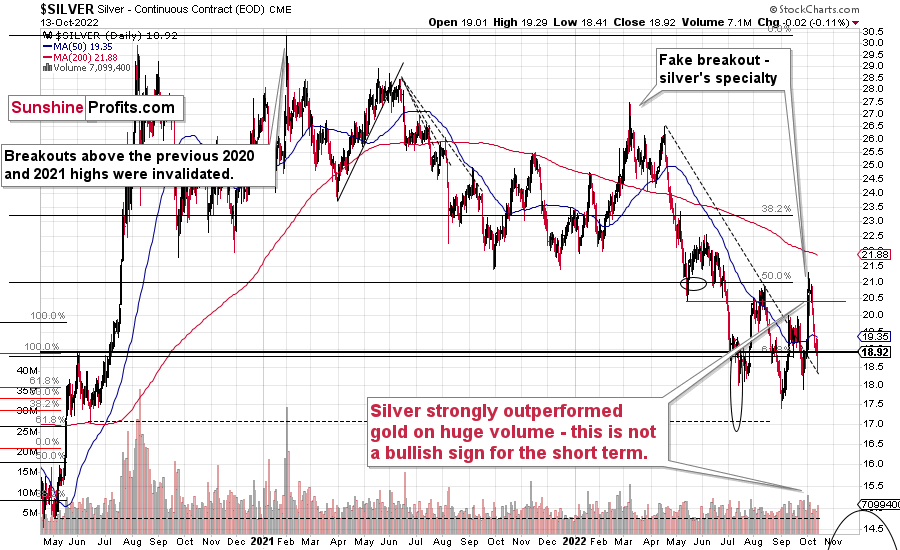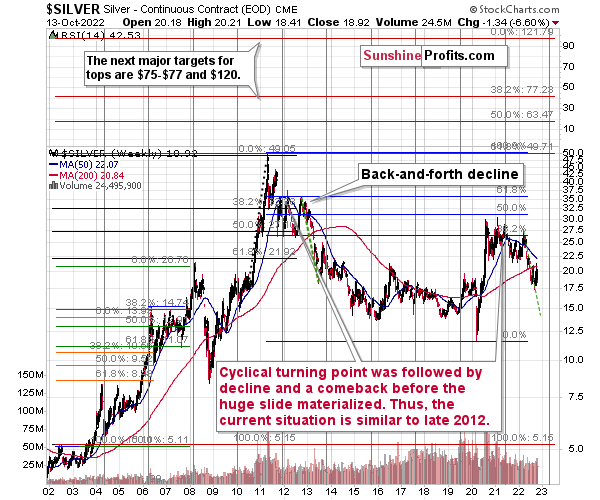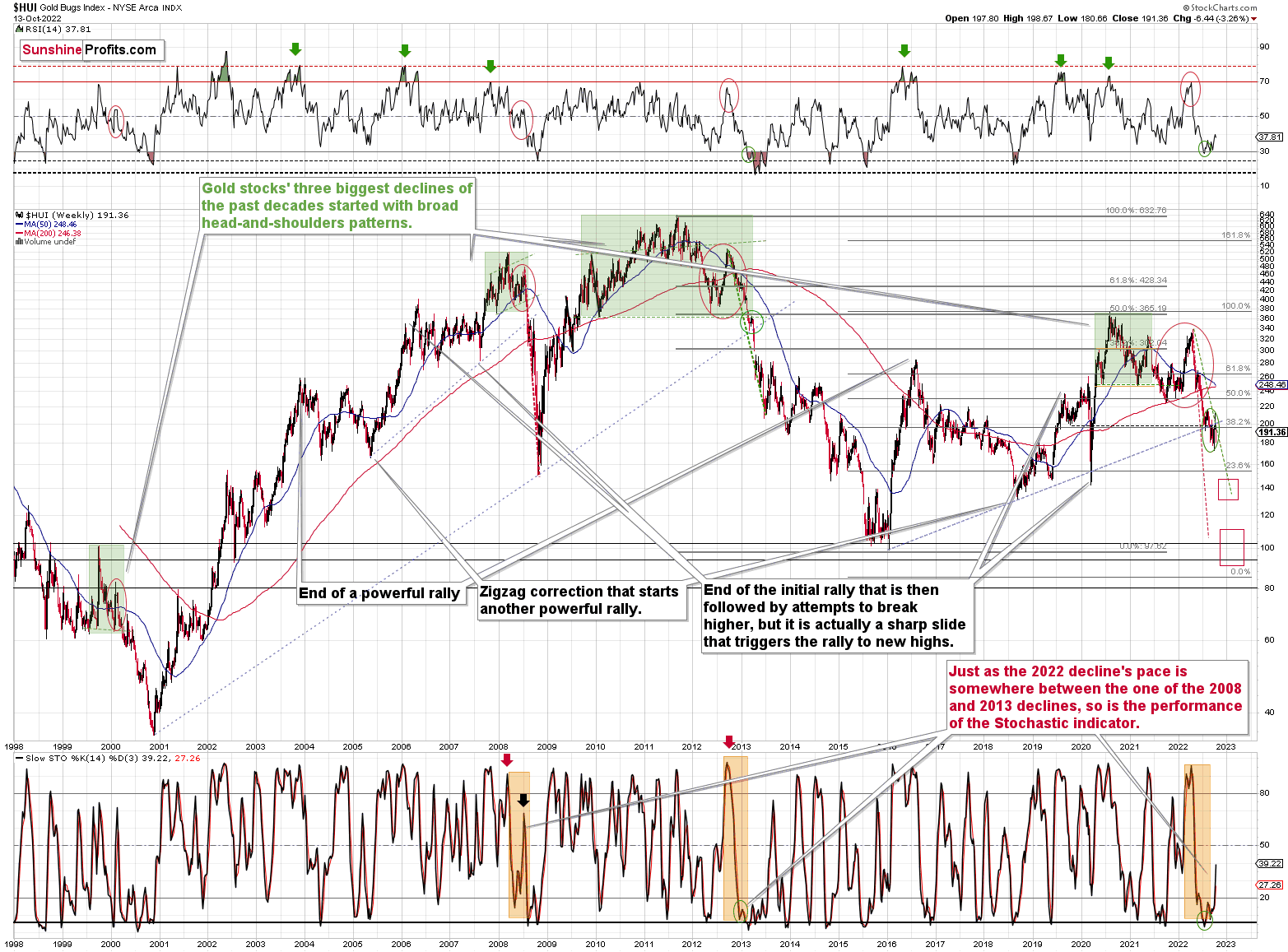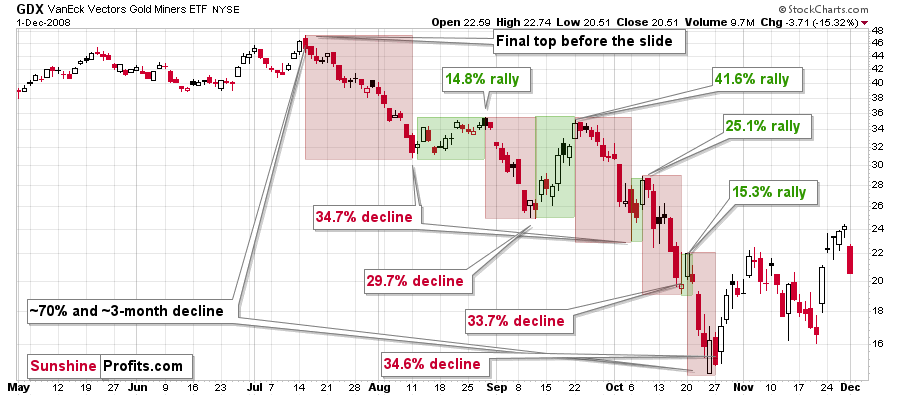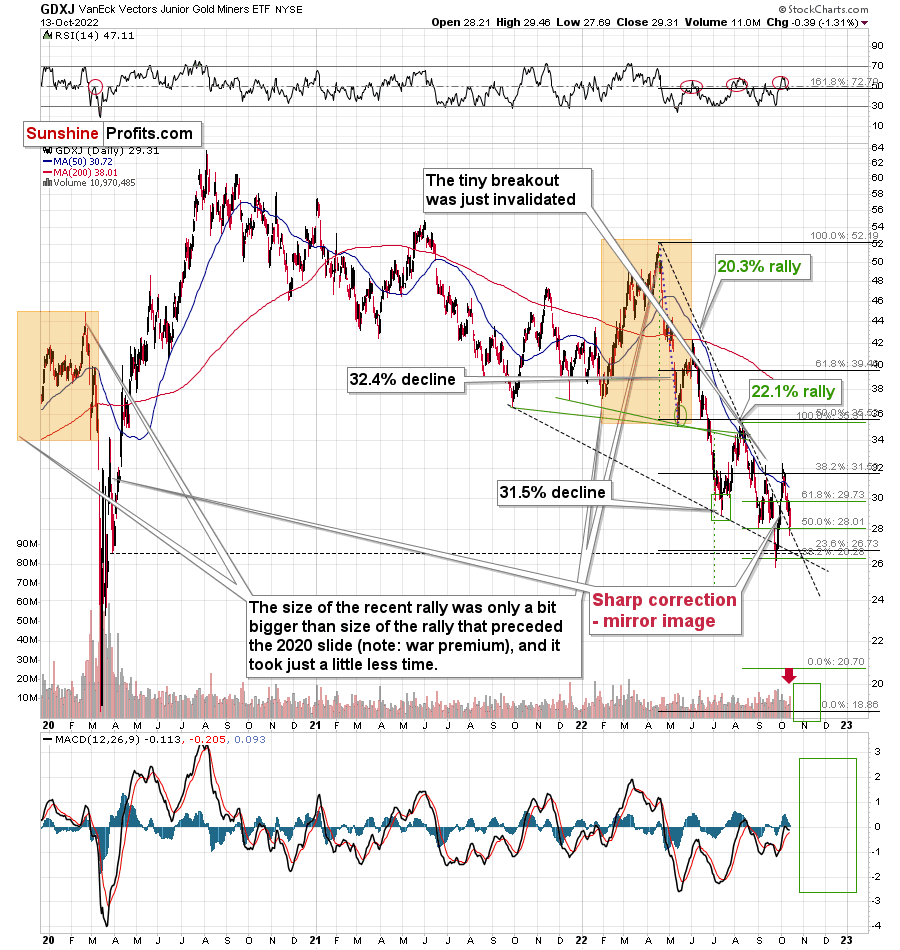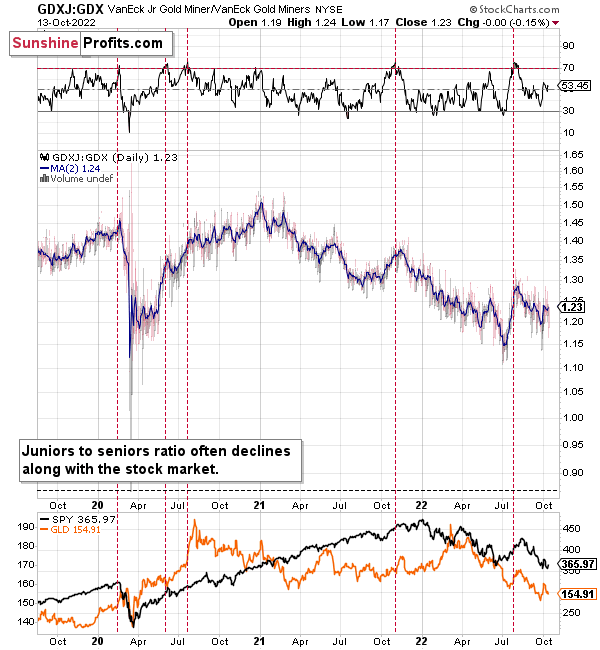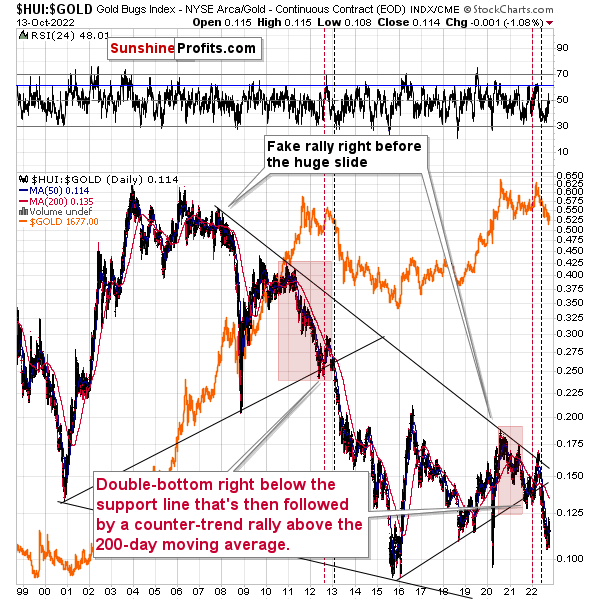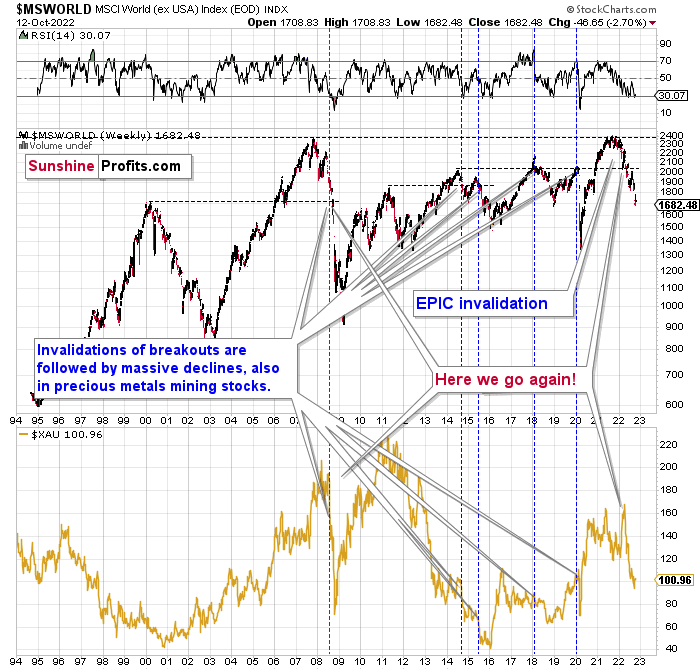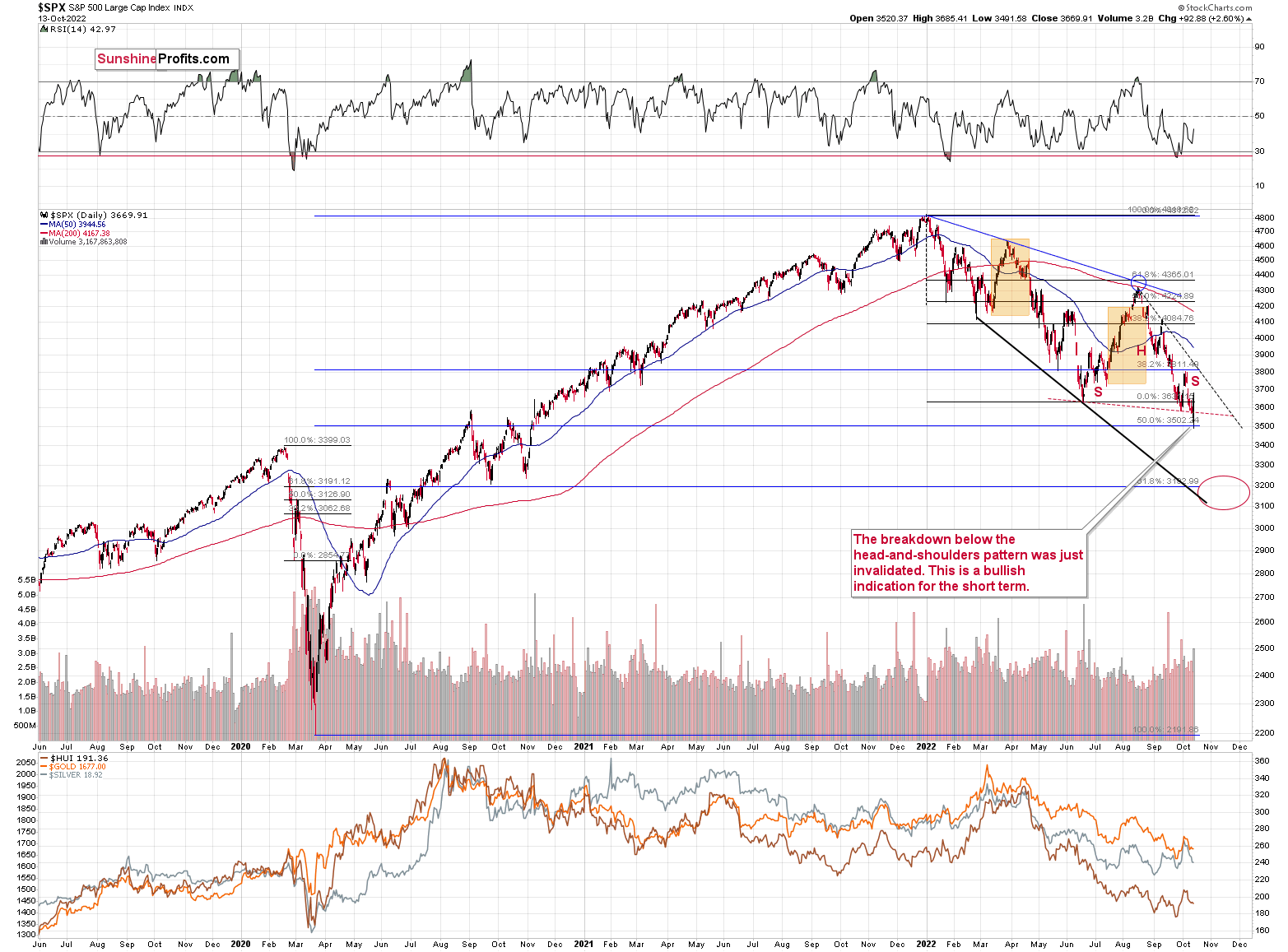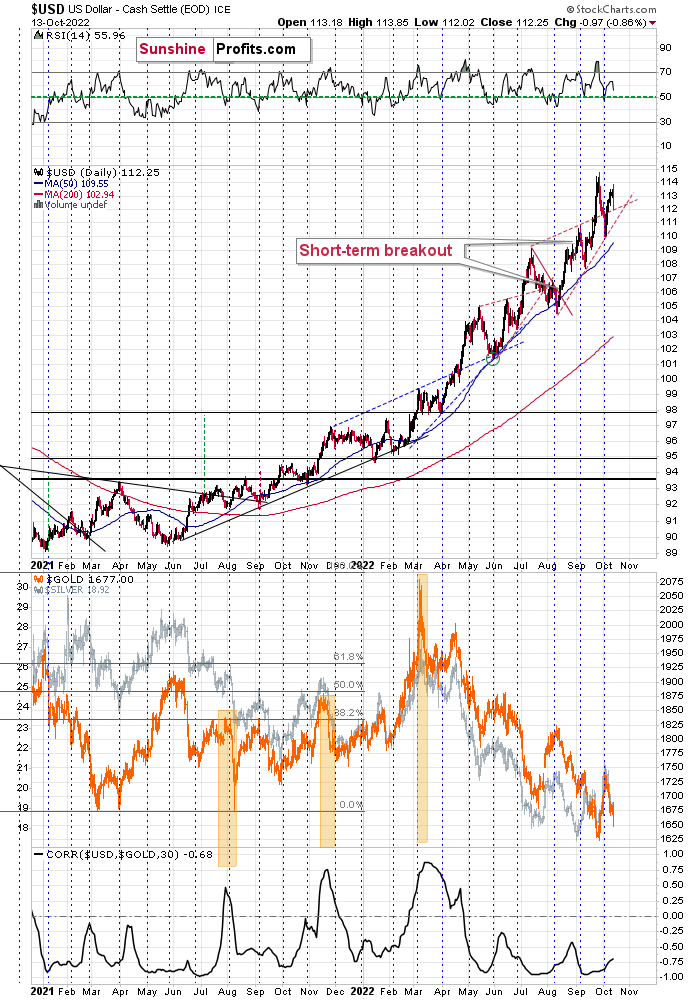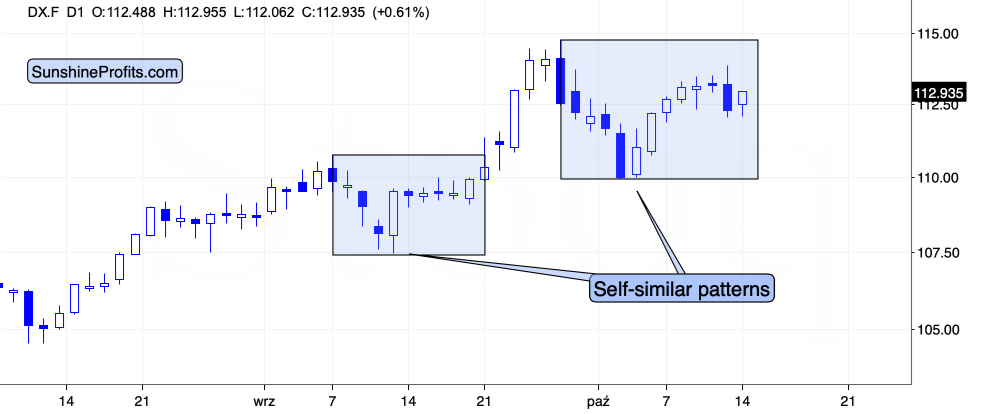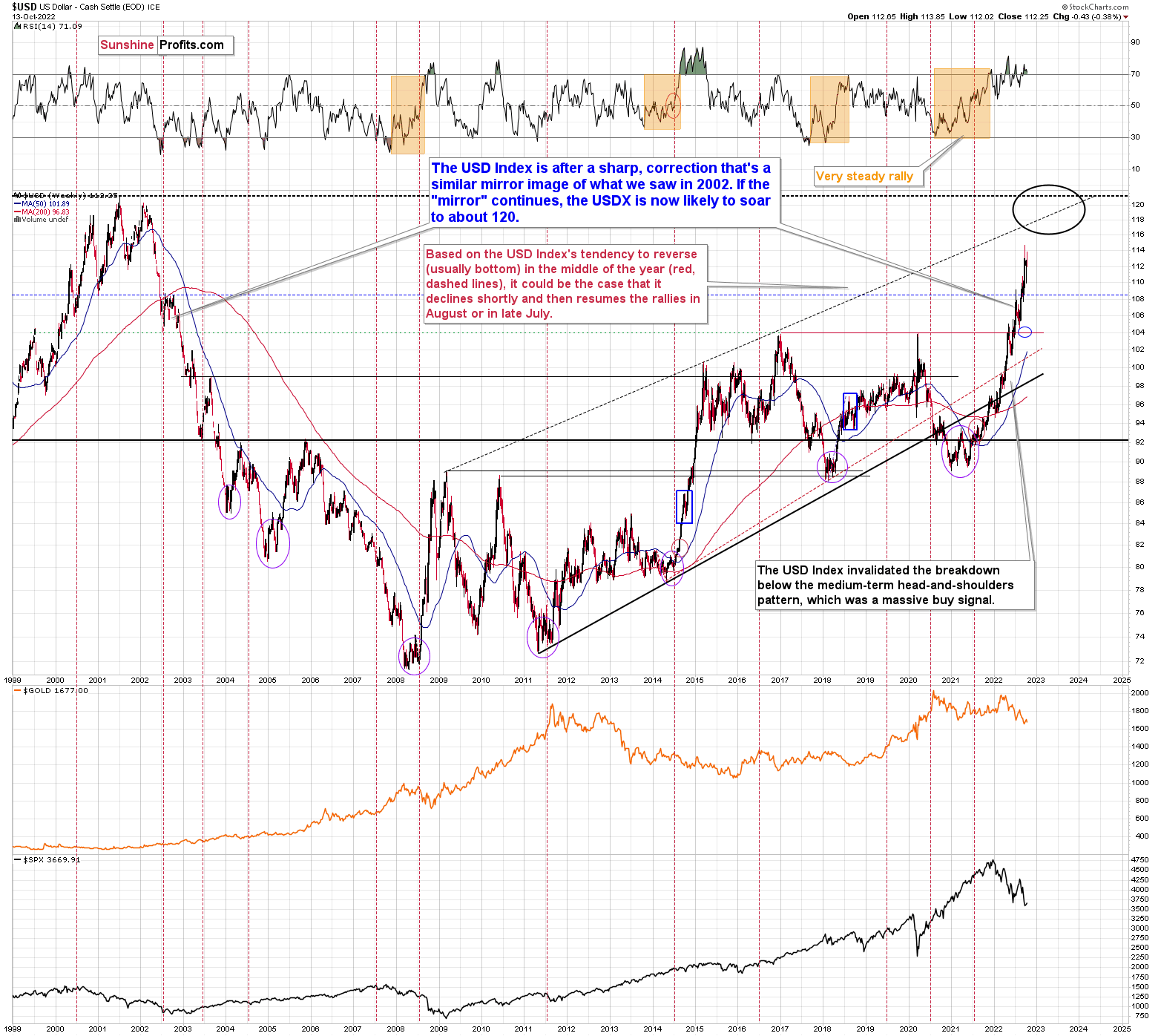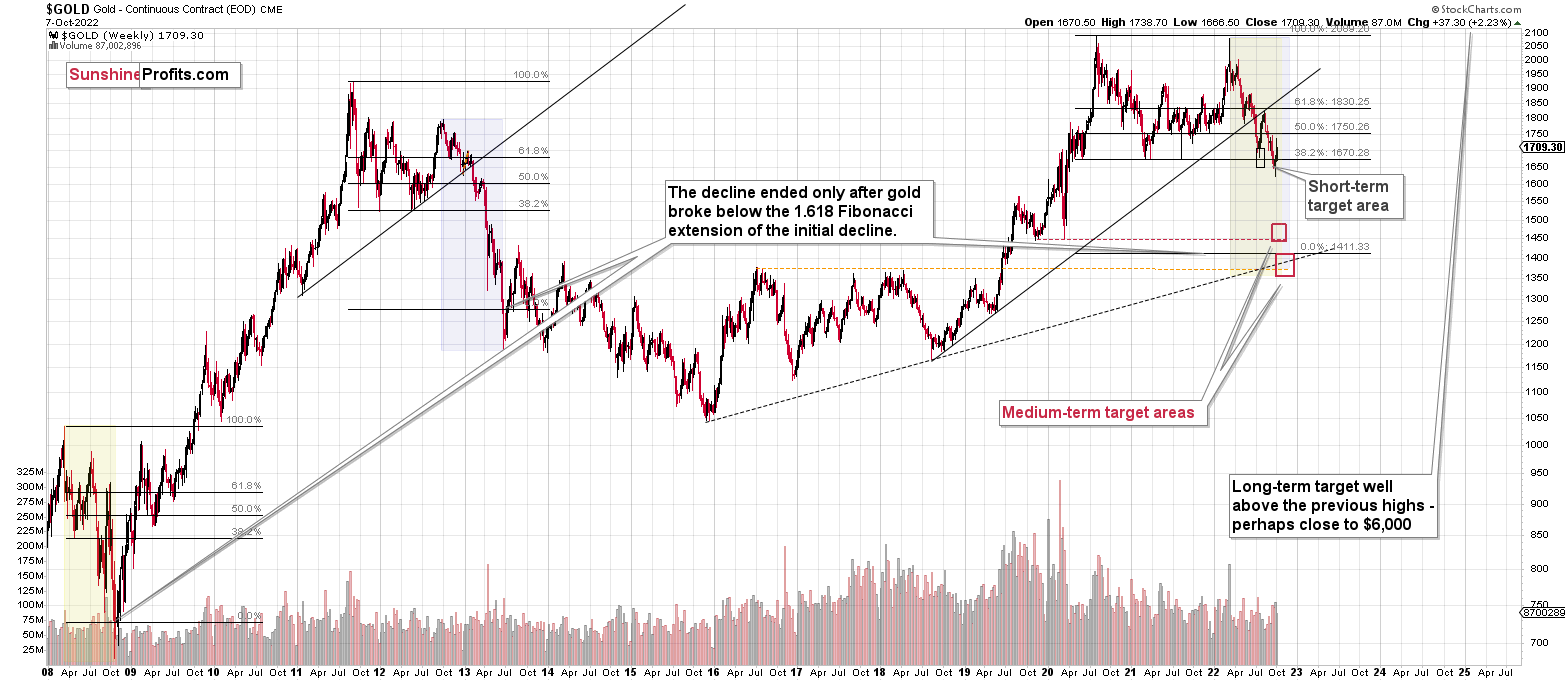Briefly: in our opinion, full (300% of the regular position size) speculative short positions in junior mining stocks are justified from the risk/reward point of view at the moment of publishing this Alert.
Welcome to this week's flagship Gold & Silver Trading Alert. Predicated on last week’s price moves, our most recently featured outlook remains the same as the price moves align with our expectations. On that account, there are parts of the previous analysis that didn’t change at all in the earlier days, which will be written in italics.
The key thing that we saw this week is the continuation of the medium-term decline after the sharp corrective upswing. Things appear to be getting back to normal. A profitable normal.
Let’s start today’s analysis with a recap of what recently happened on the fundamental front.
The Weekly Fundamental Roundup
While Fed officials continued their hawkish crusade this week, the headliner was the release of the Consumer Price Index (CPI). With the monthly print turning into the financial market equivalent of the Super Bowl, heightened volatility follows. As a result, I noted before the release that it’s important to stay level-headed and focus on the medium term. I wrote:
While a hot print may send risk assets into a tailspin and a cool print may elicit a celebration, the reality is that normalizing the metric to 2% is a challenge that’s profoundly bearish for gold, silver, mining stocks and the S&P 500.
Thus, while hot headline and core CPIs outperformed expectations on Oct. 13, the S&P 500 recorded a sharp intraday reversal, which helped the GDXJ ETF close off of the lows. Yet, the medium-term implications were unchanged, and the PMs confront an ominous fundamental backdrop.
Please see below:
To explain, the headline and core CPIs surpassed economists’ consensus estimates month-over-month (MoM) and year-over-year (YoY). As such, the Fed’s 12 25 basis point rate hikes in 2022 have done little to alleviate the pricing pressures.
To that point, the core CPI hit a new 2022 high; and with the pivot crowd suffering another defeat, nothing in the data supports a dovish 180.
Please see below:
To explain, the red line above tracks the YoY percentage change in the core CPI (which excludes the impact of food and energy). If you analyze the right side of the chart, you can see that the metric rose by ~6.66% in September. Therefore, while the supply-side enthusiasts often cite commodity shortages as the primary driver of inflation, the reality is that consumer demand remains resilient, which keeps inflation elevated. To explain, I wrote on Mar. 31:
There is a misnomer in the financial markets that inflation is a supply-side phenomenon. In a nutshell: COVID-19 restrictions, labor shortages, and manufacturing disruptions are the reasons for inflation’s reign. As such, when these issues are no longer present, inflation will normalize and the U.S. economy will enjoy a “soft landing.”
However, investors’ faith in the narrative will likely lead to plenty of pain over the medium term. For example, I’ve noted for some time that the U.S. economy remains in a healthy position; and with U.S. consumers flush with cash and a red hot labor market helping to bloat their wallets, their propensity to spend keeps economic data elevated.
Likewise, while most investors assumed that consumer spending and inflation would fall off a cliff when enhanced unemployment benefits ended in September, the reality is that neither will die easy
As further evidence, Mastercard released its SpendingPulse U.S. retail sales report on Oct. 7. An excerpt read:
“U.S. retail sales excluding automotive increased +11% YoY in September. E-commerce sales continue to grow, up +10.7% YoY, highlighting the ongoing demand for the convenience of digital commerce….
“Spending at Restaurants was up +10.9% YoY, as consumers continue to enjoy eating out. Further, travel remains a priority as spending on Airlines and Lodging experienced double-digit YoY growth. This is consistent with the past several months and broader global trends.”
So while the crowd wonders why inflation won’t die, the answer has been hiding in plain sight.
Please see below:
Furthermore, with inflation broadening and intensifying its grip on the U.S. economy, the Atlanta Fed’s Sticky CPIs hit new 2022 highs.
Please see below:
To explain, the orange and green lines above track the YoY percentage changes in the Sticky and core Sticky CPIs. If you analyze the right side of the chart, you can see that both sought higher ground in September.
In addition, a report by Atlanta and Cleveland Fed researchers highlighted the importance of the data. I noted their findings on Aug. 11:
“We are interested in whether changes in the flexible CPI or sticky CPI improve the forecast of headline inflation at various numbers of months into the future…. We find that forecasts of the headline CPI that are based on the sticky-price data tend to be more accurate than the forecasts based on headline inflation. Further, CPI predictions using sticky-price data perform pretty well relative to CPI forecasts using core CPI data. We also find that the relative accuracy of the sticky-price Phillips curve increases as the forecast horizon gets longer.”
Likewise, I’ve been warning for months that the Shelter CPI would prove problematic for the inflation bears, as the metric accounts for more than 30% of the headline CPI’s movement.
Please see below:
To explain, the red line above tracks the YoY percentage change in the Shelter CPI. If you analyze the right side of the chart, you can see that the Shelter CPI hit a new 2022 high. As such, the result is profoundly hawkish and makes a dovish pivot extremely unlikely.
In contrast, the only data point aiding the bulls' case was the deceleration in the Atlanta Fed's Wage Growth Tracker. For context, the metric declined from 6.7% in August to 6.3% in September.
Please see below:
To explain, the slight dip on the right side of the chart shows that the Fed has made some progress in cooling the U.S. labor market. However, the development is unsurprising given the substantial rise in the U.S. federal funds rate (FFR) in 2022.
Yet, wage inflation is still well above its historical norm and is nowhere near its pre-COVID-19 levels. Therefore, the data is like the JOLTS job openings, where a decline from record levels still requires more hawkish policy to achieve normalization.
So, while oversold conditions and one-sided positioning helped usher the S&P 500 into the green on Oct. 13, the GDXJ ETF materially underperformed and closed in the red. In addition, with the Fed a long way from 2% and the core CPI now outperforming the headline CPI, a rising FFR is highly bullish for the USD Index and the U.S. 10-Year real yield.
Political Pressure
With the U.S. midterm elections scheduled to commence in November, inflation is problematic for the Democrats. Moreover, U.S. Treasury Secretary Janet Yellen – who is also a former Fed chair – said on Oct. 13:
“We have more work to do" to control inflation. “As I said earlier this week, while there have been favorable indicators on easing of supply chain bottlenecks and softening of labor market pressures, we need to see sustained progress and bringing down inflation remains the President’s number one economic priority.”
Thus, with U.S. President Joe Biden echoing that sentiment, the Democrats understand that reducing inflation is paramount to their political survival.
Please see below:
I’ve said it many times, but I’m going to say it again.
Voters’ primary concern is inflation.
That’s where the effort will go.
Real rates are headed higher in the short and perhaps medium term, and precious metals prices are headed in the opposite direction.
Furthermore, while the White House may insinuate that inflation will subside soon, the reality is that demand-driven price increases continue to uplift corporate profits. For example, PepsiCo released its third-quarter earnings on Oct. 12. CEO Ramon Laguarta said:
“We are very pleased with our results for the third quarter as our global business momentum remains strong. Given our year-to-date performance, we now expect our full-year organic revenue to increase 12% (previously 10%) and core constant currency earnings per share to increase 10% (previously 8%).”
As a result, the largest food and beverage company in the U.S. raised its guidance. However, the optimism was headlined by price increases.
Please see below:
To explain, the red rectangle above shows how Frito-Lay, Quaker and PepsiCo North America realized net pricing of 20%, 20% and 12% YoY in Q3. Thus, with food inflation materially unanchored and the core CPI (which excludes food inflation) hitting a new 2022 high, does it seem like the FFR is near its peak?
In reality, the FFR still has plenty of room to run, and gold, silver, and mining stocks are unlikely to perform well as the liquidity drain unfolds.
The Bottom Line
While the S&P 500 and the GDXJ ETF closed near their highs on Oct. 13, the fundamental developments that helped create their bear markets intensified; and while the USD Index suffered a 'buy the rumor, sell the news' event, this is nothing new for the greenback, as higher highs have ensued despite several short-term blips. Likewise, while risk-on days are also bearish for the U.S. 10-Year real yield, the metric should hit new highs in the months ahead.
In conclusion, the PMs declined on Oct. 13, as they couldn't match the S&P 500's enthusiasm. But with the red close coinciding with a weaker USD Index and a lower U.S. 10-Year real yield, the relative weakness was noteworthy. As such, while risk assets may attempt to build on their daily gains, more pain should materialize over the medium term.
What to Watch for Next Week
With more U.S. economic data releases next week, the most important are as follows:
- Oct. 17: New York Fed manufacturing survey
Regional surveys are always insightful, and the data from the New York Fed will summarize the growth, employment and inflation developments in New York State.
- Oct. 19: Fed Beige Book
The Fed’s Beige Book consolidates all of the regional Fed surveys, and the results are akin to a nationwide survey. Therefore, it’s a solid leading indicator of U.S. economic developments.
- Oct. 20: Philadelphia Fed manufacturing survey
As another regional survey, the Philadelphia Fed's data will shed light on the growth, employment and inflation progress in Pennsylvania.
All in all, economic data releases impact the PMs because they impact monetary policy. Moreover, if we continue to see higher employment and inflation, the Fed should keep its foot on the hawkish accelerator. If that occurs, the outcome is profoundly bearish for the PMs.
Technically Speaking
Let’s start today’s technical discussion with a quick check on copper prices.
Practically, everything that I wrote about it last week (and in the previous weeks/months) remains up-to-date:
Copper recently CLEARLY invalidated another attempt to move above its 2011 high. This is a very strong technical sign that copper (one of the most popular commodities) is heading lower in the medium term.
It seems to me that there might be some kind of smaller corrective upswing or a pause when copper moves to about $3.0, but that it would then decline profoundly once again, only to bottom in the $2.0-2.4 area. That’s where we have rising, long-term support lines and also the previous – 2016 and 2020 – lows.
Interest rates are going up, just like they did before the 2008 slide. What did copper do before the 2008 slide? It failed to break above the previous (2006) high, and it was the failure of the second attempt to break higher that triggered the powerful decline. What happened then? Gold declined, but silver and mining stocks truly plunged.
Again, copper is after invalidation of a major breakout, a decline, the initial correction, and its decline just accelerated. Copper prices currently SCREAM that it’s 2011 or (more likely) 2008 all over again. This is extremely bearish for mining stocks (especially juniors) and silver.
No market moves in a straight line, up or down, but since we just saw a corrective upswing, the downtrend might now resume.
Based on the recent short-term move lower, it seems that the downtrend has already resumed. This month’s rebounds are barely visible from the long-term point of view, and they don’t change anything.
Having said that, let’s check junior miners’ really big picture.
I previously commented on the above chart in the following way:
The Toronto Stock Exchange Venture Index includes multiple junior mining stocks. It also includes other companies, but juniors are a large part of it, and they truly plunged in 2008.
In fact, they plunged in a major way after breaking below their medium-term support lines and after an initial corrective upswing. Guess what – this index is after a major medium-term breakdown and a short-term corrective upswing. It’s likely ready to fall – and to fall hard.
So, what’s likely to happen? We’re about to see a huge slide, even if we don’t see it within the next few days.
Having said that, let’s turn to gold.
Let’s start with context:
Between 2020 and now, quite a lot happened, quite a lot of money was printed, and we saw a war breaking out in Europe. Yet, gold failed to rally to new highs.
In fact, it’s trading very close to its 2011 high, which tells you something about the strength of this market. It’s almost absent.
Truth be told, what we see in gold is quite in tune with what we saw after the 2011 top, and in particular, shortly after the 2012 top. The long-term gold price chart below provides details.
Basically, the key thing about gold’s long-term chart is that it doesn’t show any important changes. The downtrend continues in tune with the 2013 price action, and the very recent rally is barely visible.
To clarify, it is visible, but what’s visible is still in tune with the final attempt for gold to rally in April 2013, right before the biggest part of the slide.
Gold is sometimes forced to react to some geo-political events as the safe-haven buying kicks in, but these moves are usually short-term lived. Looking at long-term charts helps to keep things in proper perspective.
Consequently, my previous comments remain up-to-date:
Based on the above chart, it’s quite clear that the situation that is now being repeated. The patterns marked with orange rectangles and blue ellipses are almost identical (also in the MACD indicator, and to a lesser extent in the RSI indicator).
Sure, the situations are not identical, as this time we had a Russian invasion of Ukraine that pushed gold temporarily higher. Other than that, the situations are extremely similar.
Based on the stage of the self-similarity and the confirmed breakdown below the $1,700 level, gold is now likely to slide.
Based on the analogy to 2013, it’s not only likely to slide, it’s likely to slide profoundly in a sharp manner. These may be the last days or hours before the slide fully begins.
How low is gold likely to go during this upcoming decline? Perhaps as low as its 2020 low – to the $1,450-1,500 area.
I realize this is far from the current price, but nonetheless, this target area appears justified in my opinion. There are two important Fibonacci retracements based on the 2015-2020 rally that gold can bounce from (it recently bounced from the 38.2% retracement). These are 50% and 61.8% retracements.
The support provided by the 61.8% retracement is strengthened by the 2020 low and the support provided by the 50% retracement is strengthened by the 2019 high.
However, based on gold’s self-similarity to 2013, it seems that we’re about to see a slide that’s bigger than what we’ve been seeing so far this year. This time – based on the similarity – gold is likely to decline profoundly, but no longer in the back-and-forth mode. If gold formed its next local low at the 50% retracement (so at about $1,560), then it might do so still within the declining, short-term trend channel (sometime in September).
However, if gold is to stick to the link to 2013, then it should decline more rapidly. In this case, the technique that can help us estimate the short-term target is the one that says that after a breakdown from a trend channel, price is likely to move approximately by as much as the height of the previous trend channel. In this case, gold could break below the trend channel soon and then decline even more. Based on the height of the trend channel, the above means that a move to the 61.8% retracement as the next downside target is more likely than a move to the 50% retracement.
I previously wrote that the above-mentioned decline in gold would likely be linked to a breakdown in the EUR/USD below 1, and we already saw both: decline in gold, and a breakdown in the EUR/USD below 1. The implications remain bearish.
Let’s zoom in on what happened in 2013 after the analogous rebound.
Well, gold consolidated for a few weeks and plunged only after that consolidation.
That’s what we saw recently as well. Of course, we haven’t seen the big plunge yet, but the other parts of the recent price patterns are very, very similar to what we saw in 2013.
Still, let’s keep in mind that history doesn’t necessarily repeat itself to the letter – it rhymes. Consequently, it’s quite possible to have two corrections from the previous lows instead of just one.
Especially if the temporary (!) effect of geopolitical events practically forces gold to move up due to safe-haven demand.
In other words, on a more-or-less basis, gold is doing exactly what it’s been doing in April 2013, right before the biggest part of the slide.
In fact, gold is down this week, and it’s now pretty much where it closed about 2 weeks ago. The corrective upswing appears to be over.
This means that right now is probably one of the worst moments to be exiting the short position in the precious metals sector, and perhaps one of the best ones to be entering the short position if one doesn’t already have it at their desired size.
Having said that, let’s zoom in to see gold’s short-term price moves.
Last week, I commented on the above chart in the following way:
Gold moved sharply higher very recently, and… It didn’t change that much.
It managed to get back above the green support/resistance zone, but it only happened after the breakdown was already verified, and it happened based on quite a few geopolitical events that happened close to each other.
Gold was still stopped by its declining medium-term resistance line and its 50-day moving average.
So, gold got a boost from almost everywhere (I even received quite a few questions about how gold would move in the event of WW3, so the level of concern regarding geopolitical stability is high), and all it managed to do was to rally a bit above $1,720 – it’s not that much.
The reasons for which gold rallied are likely either unfounded (Fed’s supposed U-turn) or temporary and likely exaggerated (geopolitical events, WW3). Consequently, gold’s rally seems to be a temporary phenomenon, and as the dust settles and the “world doesn’t end”, the bigger trends are likely to be resumed.
No wonder that gold is erasing the previous rally so quickly.
Yes, gold reversed yesterday, and it might appear bullish at first sight, but is it really so? Let’s zoom in.
Yesterday’s reversal in gold actually seems very similar to what we saw at the beginning of July. That’s when gold reversed, too. In fact, back then, gold even invalidated an intraday breakdown below the previous lows. And what happened next? Gold plunged anyway.
If it weren’t for the strong analogy to 2013 and fundamentals (rising real interest rates!), I might view yesterday’s reversal as concerning.
But given the recent analogy to early July and the profound analogy to 2013 that I already described today (and that I’ve been featuring for many months now), I just “don’t buy” the bullish narrative based on yesterday’s reversal.
The markets might be hesitating – fine.
The investors might not be convinced by what happens next – fine as well. We saw the same kind of hesitation and uncertainty right before the April 2013 slide. In fact, back then, many investors were convinced that the bottom was already in.
Yet, the 2013 analogy remains intact, and it remains likely that the next really big move will be to the downside. Consequently, I’m not really concerned by a possibility of seeing a very quick rebound here, and I think that attempting to trade it would be way too risky (against a very strong downtrend).
Besides, gold’s decline appears to continue in today’s pre-market trading.
Having said that, let’s take a look at the silver market.
Just like gold, silver reversed, and just like it’s the case with gold, I’m not buying the supposedly bullish narrative here. I don’t think anything more than a brief rebound is likely and it’s quite possible that there will actually be no additional rally – silver is down by almost 1% so far in today’s pre-market trading.
Silver’s slide from above $21 to below $19 has been very sharp, so it’s natural to see some sort of breather. It doesn’t necessarily have to be bullish.
When in doubt, take a step back and think about what really changed. And, well, nothing changed. Real rates are still going to move higher. The situation, being as bad as it is on many levels, is still better than the situation (in monetary / fiscal terms that is) in the Eurozone and Japan. Consequently, the USD Index has good reasons to strengthen.
Since real rates and the USDX are the main fundamental drivers for gold, and the technicals for gold continue to support the medium-term downtrend’s continuation, the big surprises for the precious metals sector are likely to be to the downside. The pace at which silver has declined recently appears to confirm that.
And so did silver’s very short-term outperformance that we saw at the end of the previous short-term upswing. My comments on it remain up-to-date:
In Monday’s [Oct. 3] intraday Alert and in the following days, I wrote the following about silver’s outperformance:
“The precious metals market moved higher today, and I just received the following question:
“What is happening with silver?”
The thing is that silver soared in a major way today, gaining about $1.5. It moved above its September 2022 high, and almost touched its August high.
The GDXJ did move above $30 (it has yet to close above it, though), and gold moved a bit above its late-September highs, and the downtrend in both markets remains visibly intact.
However, silver soared. What gives?
Those, who have been following my analyses for some time likely know what this means. It means that the current move up is likely fake. Silver tends to outperform gold in a major, yet brief way, right at the end of a given upswing, or close to it.
That’s exactly what we see today.
The S&P 500 futures are up today, but let’s not forget that they broke to new yearly lows in weekly terms. Therefore, it would take more than a daily rally to invalidate this bearish indication. Do you remember the Sep. 28 session, where stocks “invalidated” the breakdown to new lows? Well, it was followed by another slide. Since Friday’s breakdown was more important (weekly!), it seems that the bearish forces are likely to return shortly this time as well. And with them, lower gold, silver, and mining stock values.
All in all, the very bearish outlook for the following weeks/months remains intact.”
Now, we know that silver’s daily rally was accompanied by one of the biggest volume readings that we’ve seen so far this year. This makes the above even more up-to-date.
The session with the highest volume was the 2022 top, by the way.
So, where do we go from here?
If you’d like a price prediction for the next three days, then I don’t think it’s possible for anyone to provide it. The markets are volatile and are focusing on pretty much random things at the moment. I described what the reality is, and I described what people choose to focus on instead. Emotions, not logic, drive these price moves. Consequently, we could theoretically use – as always – technical tools. However, with this kind of volatility, it’s possible that we get an immediate turnaround, but it’s also possible that the rally remains sharp for several hours – days, and we get a massive reversal only then.
Fortunately, we’re not in the day-trading business, and I haven’t written about short positions in silver, either (the price levels for silver and gold are only provided as some subscribers request that). This means that we can simply continue to focus on what’s much more predictable by using tools that don’t just randomly stop being useful.
The link to 2013 remains intact, and so does the very bearish outlook. When in doubt, or when things appear too hectic, and you want to drop the towel, give up, and run for the hills, take several deep breaths, and return to the long-term charts. Has anything major happened to them. No. So, whatever you see is most likely just short-term price noise.
Investing and trading are simple but not easy. This year has been extremely profitable so far, but no market can move up or down without corrections, and no position can grow more and more profitable each day – there have to be some corrections. The key thing is how one approaches those days. Will one allow short-term emotions to cloud their vision, or will one stand firm and in tune with the original strategy?
I can’t make any guarantees with regard to gold’s price performance or profitability, but I do think that this counter-trend upswing is just a very temporary phenomenon, and that the big downtrend remains intact. In my opinion, the short position in junior mining stocks remains justified from the risk to reward point of view, and I’m keeping my position intact. Of course, whatever you decide to do with your money is completely up to you – it’s your capital, after all.
Silver just invalidated the breakout above its August highs in terms of the closing prices.
That’s one of the reasons to support the scenario in which the precious metals market has already topped.
Of course, I can’t guarantee that this has indeed happened, and – as I emphasized earlier – I’m not even attempting to day-trade the current situation, as I don’t think that’s where the best risk/reward opportunity lies. In my view, the optimal risk-to-reward opportunity is to gain thanks to the huge, medium-term decline that’s in tune with what happened in 2013 and 2008. That’s what provided huge profits so far this year, and while I can’t promise anything, in my opinion, those profits are going to increase substantially before the year is over.
Let’s keep in mind that while gold is repeating its 2013 performance, so is silver.
As you can see on the above chart, silver corrected about 50% of the previous downswing, and this correction ended at about $30, a long time ago. Ever since, silver has been declining, and even the outbreak of war in Europe didn’t make silver rally above that level.
On the above chart, you can see how silver first topped in 2011, then declined and formed another top at the cyclical turning point. Next, it declined once again – to the previous lows. After that, silver rallied (in 2012 and 2022), and it topped between its 50-week moving average (marked in blue) and the previous top. Now silver is declining in a back-and-forth manner (you can see it more clearly on the previous short-term silver chart).
Back in 2012, these were just the early days of a gargantuan decline, and the same appears likely to be the case this time. Interest rates are going up after all, and the Fed is determined to quench inflation.
Let’s not forget that rising interest rates are likely to negatively impact not just commodities, but practically all industries. This will likely cause silver’s price to decline profoundly, as silver’s industrial demand could be negatively impacted by lower economic growth (or a decline in economic activity).
Besides, please note that silver didn’t even manage to rally as much as copper (which tried to move to new highs recently) or most other commodities, thus being rather weak.
Consequently, it seems that silver will need to decline profoundly before it rallies (to new all-time highs) once again.
Having said that, let’s take a look at what happened in mining stocks.
History tends to repeat itself. Not to the letter, but in general. The reason is that while economic circumstances change and technology advances, the decisions to buy and sell are still mostly based on two key emotions: fear and greed. They don’t change, and once similar things happen, people’s emotions emerge in similar ways, thus making specific historical events repeat themselves to a certain extent.
For example, right now, gold stocks are declining similarly to how they did in 2008 and in 2012-2013.
As gold was practically forced to rally recently based on geo-political events (UK’s QE, tactical nuclear warfare scare, Iranian protests), so were gold stocks.
Did it change anything technically?
Only briefly. This week’s decline and invalidation of the temporary move back above the rising medium-term support/resistance line confirm that this move was forced and rather artificial.
The above provides the perspective needed to properly assess the situation in the precious metals market. Gold stocks often lead the rest of the sector, and right now they are after a major breakdown and its confirmation. This is extremely bearish and much more important than gold’s yesterday’ reversal.
Since the analogies to 2013 and 2008 were not invalidated because of this upswing, my previous comments on the above chart remain up-to-date:
The key analogies in the case of the HUI Index (I’m using this chart as it has the most long-term scope) are to 2008 and 2013.
In 2008, there was a move higher in the stochastic that accompanied a sharp – but temporary – upswing that was then followed by a much bigger decline.
In 2013, there was a series of tiny upswings that didn’t really change anything.
Right now, we see something in between the above.
On multiple occasions, I wrote that the situation right now is somewhat similar to what we saw in 2013 (mostly), but it also has a 2008 vibe to it.
Even so, the pace at which gold stocks are declining is between both declines: the 2008 and 2013 ones. I marked this with dashed lines.
Please note the green, dashed line that starts at the late-2012 top and the one that starts at the 2022 top. Those lines are identical. You can see that back in 2012 and 2013, the HUI Index traded above this line. This time, it’s trading below it – gold stocks are declining faster.
Faster declines imply sharper corrections – as emotions get hotter.
So, does Stochastic’s performance indicate an even bigger rally here? Not necessarily.
Was the current rally very likely based on stochastic? Possible – yes, but very likely – no. The link to 2013 is still more visible and more important.
How low can the HUI Index fall during the next big downswing?
As it’s the case with gold and silver, a move back to the 2020 lows is definitely in the cards. Please note that this level is also strengthened (as support) by other major lows: the 2019, 2014, and 2008 ones.
However, I wouldn’t rule out a move even lower on a temporary basis. If gold were to decline to about $1,450-1,500, it would mean that it would double its current 2022 decline. If the HUI Index does that, it will move below 150.
So, all in all, 120-150 is my current target area for the upcoming slide in the HUI Index.
All right, let’s zoom in and see how mining stocks declined in 2008.
Back then, the GDXJ ETF was not yet trading, so I’m using the GDX ETF as a short-term proxy here.
The decline took about 3 months, and it erased about 70% of the miners’ value. The biggest part of the decline happened in the final month, though.
However, the really interesting thing about that decline – that might also be very useful this time – is that there were five very short-term declines that took the GDX about 30% lower.
I marked those declines with red rectangles. After that, a corrective upswing started. During those corrective upswings, the GDX rallied by 14.8-41.6%. The biggest corrective upswing (where GDX rallied by 41.6%) was triggered by a huge rally in gold, and since I don’t expect to see anything similar this year, it could be the case that this correction size is an outlier. Not paying attention to the outlier, we get corrections of between 14.8% and 25.1%.
Fast forward to the current situation. Let’s take a look at the GDXJ ETF.
Just like the rest of the precious metals sector, the GDXJ ETF moved higher recently. And, just like gold and silver, the junior mining stocks declined sharply after the corrective upswing.
In other words, my previous expectations based on the above chart were realized:
That’s the fourth attempt of the GDXJ to break above its 50-day moving average (marked in blue). All previous cases failed, and in all previous cases the rally taking prices to this MA were sharp.
Is this time different? That’s unlikely, as the fundamentals (as explained earlier today) haven’t changed.
Additionally, please note that the RSI just jumped above 50, and ever since the April 2022 top, these levels in the RSI meant that local tops were in. I marked that with red ellipses in the upper part of the chart.
There’s also one additional factor explaining why this counter-trend bounce might be so volatile – that’s because the mirror image of this decline – the 2020 rally – also features a sharp correction around those price levels.
This time, the correction doesn’t have to be as big as the move that led to it was not as sharp.
Now, as you may recall, I previously had a downside target of about $26, but I ended up resigning from it. I continue to think that this decision was justified from the risk to reward point of view (given the data that we had available at that time), as there were previously corrective upswings, and it was not a no-brainer that we’re going to see a rebound also one more time.
However, as geopolitics came into play this time, the counter-trend rally has indeed materialized. Since it doesn’t make much sense to try to predict those near-term geopolitical events – the world is too unpredictable, it’s better to focus on the part of the picture where we can actually gain an extra edge over other market participants. That is recognizing trends and tendencies. Once the very short-term dust settles, the markets are likely to get back to their previous trends and surprise those who assume that short-term geopolitical events have a lasting impact on the markets. They don’t. If that was the case, gold would be above $2,000 at this time, as that’ where it soared based on the Russian invasion. Well, the war didn’t end, and yet gold is at about $1,700.
Indeed, the RSI appears to have topped in the area that I marked, just like it did twice earlier this year. It seems that the decline can now continue, regardless of the immediate-term performance.
Meanwhile, the relative performance of junior miners compared to senior miners continues to deteriorate in a medium-term trend.
During this quick upswing, juniors rallied relative to seniors, but this is just a very short-term move that’s within a short-, and medium-term downtrends.
This implies bigger declines in the GDXJ in the future.
Also, let’s not forget about the forest while looking at individual trees. By that, I mean looking at how gold stocks perform relative to gold. That’s one of the major indications that the current situation is just like what we saw at the 2012 top.
The situation in the gold stock to gold ratio is similar to what we saw in late 2012 and early 2013. The HUI to gold ratio invalidated its first attempt to break lower (marked with red, dashed lines), but after a corrective upswing, it then broke lower more decisively. That’s what I marked using black, dashed lines.
Recently, we saw a quick upswing in the ratio, but that’s not a game-changer – even the biggest declines had quick corrections in the past.
If history is to rhyme, we’re about to see a profound decline. In fact, we’re likely already past its beginning.
Also, please note that the pattern that we currently see, which started in early 2016, is somewhat similar to what happened between 2003 and 2008.
Back in 2008, the breakdown from the consolidation resulted in sharply lower ratio values and much lower prices of gold stocks.
So, if the situation is analogous to 2012-2013, we’re likely to see a big decline in the following weeks/months, and if it’s analogous to 2008, we’re likely to see an enormous decline in the following weeks/months.
Declining stock prices would only add fuel to the bearish fire (after all, gold stocks are… just stocks) and that’s exactly what’s likely to happen.
The technical picture in the case of world stocks remains extremely bearish, and my previous comments on it were just confirmed.
After a brief pause, the freefall continues, just like in 2008. This has profoundly bearish implications for the mining stocks that declined severely back then.
Here’s what I’ve been writing about the above chart for quite a few weeks now:
World stocks have already begun their decline, and based on the analogy to the previous invalidations, the decline is not likely to be small. In fact, it’s likely to be huge.
For context, I explained the ominous implications on Nov. 30. I wrote:
Something truly epic is happening in this chart. Namely, world stocks tried to soar above their 2007 high, they managed to do so, and… failed to hold the ground. Despite a few attempts, the breakout was invalidated. Given that there were a few attempts and that the previous high was the all-time high (so it doesn’t get more important than that), the invalidation is a truly critical development.
It's a strong sell signal for the medium - and quite possibly for the long term.
From our – precious metals investors’ and traders’ – point of view, this is also of critical importance. All previous important invalidations of breakouts in world stocks were followed by massive declines in mining stocks (represented by the XAU Index).
Two of the four similar cases are the 2008 and 2020 declines. In all cases, the declines were huge, and the only reason why they appear “moderate” in the lower part of the above chart is that it has a “linear” and not a “logarithmic” scale. You probably still remember how significant and painful (if you were long, that is) the decline at the beginning of 2020 was.
All those invalidations triggered big declines in the mining stocks, and we have “the mother of all stock market invalidations” at the moment, so the implications are not only bearish, but extremely bearish.
World stocks have declined below their recent highs, and when something similar happened in 2008, it meant that both stocks and gold and silver mining stocks (lower part of the chart) were about to slide much further.
The medium-term implications for mining stocks are extremely bearish.
However, let’s get back to the short- and medium-term points of view.
While stocks have already erased their entire recent short-term rally (and they even moved to new yearly lows), they reversed during yesterday’s session. What does it imply?
At first sight, it’s bullish. There’s a head-and-shoulders formation in stocks that I marked on the above chart, and stocks first broke below the neck level of the formation, and then they immediately invalidated this breakdown. That’s a buy signal.
However, given the current fundamental reality, should one trust this bullish signal? That is a very good question.
Maybe stocks weren't supposed to fall just yet, and they'll fall on the second try. Or maybe they will rally up to their previous short-term highs and the declining dashed resistance line at about 3,800?
Both are quite possible.
However, regardless of which of those scenarios is realized, I don’t think that this would change the medium-term trend, which remains down.
The big surprises are still likely to be to the downside. And if the upside target is at about 3,800, this means that half of the rally (from yesterday’s intraday low) is already over. And junior miners still declined on a day-to-day basis despite yesterday’s rally.
What does it all mean?
In my opinion, it means that the short-term outlook for stocks is unclear, the medium-term outlook for stocks remains bearish, and the short- and medium-term outlooks for junior mining stocks remain bearish. Even if we see some immediate-term strength in the latter, I think it will be very temporary.
As interest rates are likely to go up, the stock market is likely to go down – perhaps as low as 3,200 on a short-term basis – and then – after a correction – even lower.
Most interestingly, though, such a decline would likely have a devastating effect on the prices of mining stocks (especially junior mining stocks) and silver. There might be some impact on gold, too.
The above would also be in tune with an extra rally in the USD Index. After all, less competitive exports are not that favorable for the U.S. economy.
In yesterday’s analysis, I commented on the above chart in the following way:
Before moving to the fundamentals, I’d like you to take a look at the below USD Index chart, and appreciate how perfectly the monthly turning point worked recently.
On Oct. 3, I wrote the following:
Nothing changed in the USD Index – it just verified the breakout above its rising support/resistance line. It declined close to the turn of the month, which is when it tends to reverse its course.
As the breakout held, the outlook for the U.S. dollar remains bullish, and given the above-mentioned monthly seasonality for the dollar, it seems that the rally is likely to resume any day now.
Indeed, the USD Index’s rally resumed just a few days later.
Did yesterday’s rally change anything? No, it didn’t. No market moves up or down without periodic corrections. Besides, please take a look at the USD Index’s very short-term chart.
It turns out that what we’ve seen in recent weeks is similar to what we had just seen days before. This time it’s happening on a bigger scale, but since markets tend to be self-similar (proportionate moves can be similar, not necessarily identical ones), the implications are bullish nonetheless.
Jjust as the late-September rally was bigger than the mid-September decline, the following rally could be bigger than the September-October correction.
In other words, the USD Index could rally any day or hour now, and the opposite is likely for the precious metals sector.
So, overall, it seems that history rhymed, and the USD Index bottomed close to the turn of the month once again.
From the long-term point of view, the USD Index is currently rallying in approximately the mirror image of how it declined in 2002. Based on this, it seems that one shouldn’t be surprised by a rather quick move from the current levels to about 120 – USD Index’s long-term highs. Of course, the implications for the precious metals market are profoundly bearish.
This doesn’t rule out quick corrections along the way – those don’t interrupt the big, weekly/monthly moves at all, and they don’t break the analogy. This includes the recent downswing – it didn’t invalidate the bullish medium-term uptrend.
This is extremely bearish for gold and the rest of the precious metals sector.
Overview of the Upcoming Part of the Decline
- It seems to me that the corrective upswing is over, and that the next big move lower is already underway.
- If we see a situation where miners slide in a meaningful and volatile way while silver doesn’t (it just declines moderately), I plan to – once again – switch from short positions in miners to short positions in silver. At this time, it’s too early to say at what price levels this could take place and if we get this kind of opportunity at all – perhaps with gold prices close to $1,600.
- I plan to switch from the short positions in junior mining stocks or silver (whichever I’ll have at that moment) to long positions in junior mining stocks when gold / mining stocks move to their 2020 lows (approximately). While I’m probably not going to write about it at this stage yet, this is when some investors might consider getting back in with their long-term investing capital (or perhaps 1/3 or 1/2 thereof).
- I plan to return to short positions in junior mining stocks after a rebound – and the rebound could take gold from about $1,450 to about $1,550, and it could take the GDXJ from about $20 to about $24.
- I plan to exit all remaining short positions once gold shows substantial strength relative to the USD Index while the latter is still rallying. This may be the case with gold prices close to $1,400 and GDXJ close to $15 . This moment (when gold performs very strongly against the rallying USD and miners are strong relative to gold after its substantial decline) is likely to be the best entry point for long-term investments, in my view. This can also happen with gold close to $1,400, but at the moment it’s too early to say with certainty.
- The above is based on the information available today, and it might change in the following days/weeks.
You will find my general overview of the outlook for gold on the chart below:
Please note that the above timing details are relatively broad and “for general overview only” – so that you know more or less what I think and how volatile I think the moves are likely to be – on an approximate basis. These time targets are not binding nor clear enough for me to think that they should be used for purchasing options, warrants, or similar instruments.
Letters to the Editor
Q1: Quick question, did today have a number come out I wasn't aware of? Big swings in silver today. There had to be some news to move the markets this way.
Q2: Is it possible gold could dump like bitcoin did? If it did, would it cover at the suggested price, wait and reshort?
A: It seems to me that this move was more technical than fundamental. It seems that all these moves (gold, silver, bitcoin) were related to the stock market’s breakdown and its invalidation. And, as I wrote earlier today, I don’t think that this will make the markets rally in the medium term. Furthermore, the impact on the precious metals market might be very limited. In fact, the decline in PMs might already be back at the moment of writing these words.
I don’t think it’s justified from the risk to reward point of view to adjust the short position in junior mining stocks at this time. The possible upside seems very limited and very uncertain, while the possible downside appears huge and very likely. Of course, that’s just my opinion, not investment advice.
Summary
Summing up, it seems that the biggest part of the 2013-like decline is taking place right now, and – while I can’t make any promises regarding performance - it seems likely to me that our big profits are about to become huge, and then ridiculously big in the relatively near future.
As far as this quick corrective upswing is concerned, it seems that it might already be over.
The current quick upswing most likely doesn’t change anything. Fundamentals and technicals continue to point to lower precious metals values in the coming weeks / months. The current geopolitical news-based rally is likely to serve as nothing more than just a verification of the breakdown below the previous lows in gold.
Things might happen very fast in the coming days, and if I plan to make any adjustments, I’ll keep you informed. Still, if the targets that I’m mentioning in the “Trading” part of the summary are reached, I think that profits should be taken off the table without an additional confirmation from me. I will probably get on the long side of the market at that time, but I’ll send a confirmation if I decide to do so.
After the final sell-off (that takes gold to about $1,350-$1,500), I expect the precious metals to rally significantly. The final part of the decline might take as little as 1-5 weeks, so it's important to stay alert to any changes.
As always, we'll keep you – our subscribers – informed.
To summarize:
Trading capital (supplementary part of the portfolio; our opinion): Full speculative short positions (300% of the full position) in junior mining stocks are justified from the risk to reward point of view with the following binding exit profit-take price levels:
Mining stocks (price levels for the GDXJ ETF): binding profit-take exit price: $20.32; stop-loss: none (the volatility is too big to justify a stop-loss order in case of this particular trade)
Alternatively, if one seeks leverage, we’re providing the binding profit-take levels for the JDST (2x leveraged). The binding profit-take level for the JDST: $27.87; stop-loss for the JDST: none (the volatility is too big to justify a SL order in case of this particular trade).
For-your-information targets (our opinion; we continue to think that mining stocks are the preferred way of taking advantage of the upcoming price move, but if for whatever reason one wants / has to use silver or gold for this trade, we are providing the details anyway.):
Silver futures downside profit-take exit price: $12.32
SLV profit-take exit price: $11.32
ZSL profit-take exit price: $74.87
Gold futures downside profit-take exit price: $1,504
HGD.TO – alternative (Canadian) 2x inverse leveraged gold stocks ETF – the upside profit-take exit price: $18.47
HZD.TO – alternative (Canadian) 2x inverse leveraged silver ETF – the upside profit-take exit price: $46.87
Long-term capital (core part of the portfolio; our opinion): No positions (in other words: cash)
Insurance capital (core part of the portfolio; our opinion): Full position
Whether you’ve already subscribed or not, we encourage you to find out how to make the most of our alerts and read our replies to the most common alert-and-gold-trading-related-questions.
Please note that we describe the situation for the day that the alert is posted in the trading section. In other words, if we are writing about a speculative position, it means that it is up-to-date on the day it was posted. We are also featuring the initial target prices to decide whether keeping a position on a given day is in tune with your approach (some moves are too small for medium-term traders, and some might appear too big for day-traders).
Additionally, you might want to read why our stop-loss orders are usually relatively far from the current price.
Please note that a full position doesn't mean using all of the capital for a given trade. You will find details on our thoughts on gold portfolio structuring in the Key Insights section on our website.
As a reminder - "initial target price" means exactly that - an "initial" one. It's not a price level at which we suggest closing positions. If this becomes the case (as it did in the previous trade), we will refer to these levels as levels of exit orders (exactly as we've done previously). Stop-loss levels, however, are naturally not "initial", but something that, in our opinion, might be entered as an order.
Since it is impossible to synchronize target prices and stop-loss levels for all the ETFs and ETNs with the main markets that we provide these levels for (gold, silver and mining stocks - the GDX ETF), the stop-loss levels and target prices for other ETNs and ETF (among other: UGL, GLL, AGQ, ZSL, NUGT, DUST, JNUG, JDST) are provided as supplementary, and not as "final". This means that if a stop-loss or a target level is reached for any of the "additional instruments" (GLL for instance), but not for the "main instrument" (gold in this case), we will view positions in both gold and GLL as still open and the stop-loss for GLL would have to be moved lower. On the other hand, if gold moves to a stop-loss level but GLL doesn't, then we will view both positions (in gold and GLL) as closed. In other words, since it's not possible to be 100% certain that each related instrument moves to a given level when the underlying instrument does, we can't provide levels that would be binding. The levels that we do provide are our best estimate of the levels that will correspond to the levels in the underlying assets, but it will be the underlying assets that one will need to focus on regarding the signs pointing to closing a given position or keeping it open. We might adjust the levels in the "additional instruments" without adjusting the levels in the "main instruments", which will simply mean that we have improved our estimation of these levels, not that we changed our outlook on the markets. We are already working on a tool that would update these levels daily for the most popular ETFs, ETNs and individual mining stocks.
Our preferred ways to invest in and to trade gold along with the reasoning can be found in the how to buy gold section. Furthermore, our preferred ETFs and ETNs can be found in our Gold & Silver ETF Ranking.
As a reminder, Gold & Silver Trading Alerts are posted before or on each trading day (we usually post them before the opening bell, but we don't promise doing that each day). If there's anything urgent, we will send you an additional small alert before posting the main one.
Thank you.
Przemyslaw K. Radomski, CFA
Founder, Editor-in-chief



